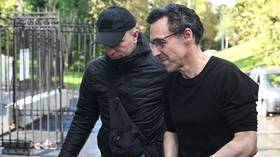Saddam Hussein’s tomb destroyed in battle for Iraqi Tikrit (VIDEO)
The tomb of former Iraq leader Saddam Hussein, has been reduced to concrete rubble during a battle between ISIS and Iraqi forces over control of Tikrit. It is still unclear which side is responsible for the act.
Clashes between the Islamic State (IS, formerly ISIS) militants and Iraqi forces intensified on Sunday when the latter announced that they were going to regain control over Mosul city within 48 hours. Most battles take place to the north south of the city.
Witnesses say only the building's columns remained intact. The complex used to be a marble mausoleum in the village of al-Awja.
Hussein’s poster-sized pictures, which previously covered the crypt have now been replaced with Shiite flags and photos of militia leaders.
READ MORE: Ancient statues destroyed by ISIS fake, real ones safe – report
Capitan Yasser Nu’ma, an official with the Shiite militias, formerly known as the Popular Mobilization Forces, said Hussein’s native village Al-Auja suffered from the biggest attack as his tomb is located there. ISIS militants place bombs and explosives around the charnel to make traps for Iraqi forces, he added.
Tikrit has been controlled by ISIS militants since June 2014. In November they destroyed the tomb of Saddam Hussein’s father which was also located there.
“This is one of the areas where IS militants massed the most because Saddam’s grave is here,” Captain Yasser Numa, an official with the Shia militias, formerly known as the Popular Mobilisation Forces, told AP.
According to Numa, the IS militants have been planting bombs around the tomb, thus, setting a trap.
In August ISIS claimed that they completely destroyed Saddam's tomb, but local officials said that it suffered only minor damage, and had just been ransacked and burned.
grave Saddam Hussein #Iraq#TikritOppic.twitter.com/jo1ySElwWR
— Methaq Al -fayydh (@AlFayth) March 16, 2015
Saddam Hussein came to power in Iraq in 1979 and was toppled in 2003 as a result of the US invasion. In 2006 he pleaded guilty to crimes against humanity for the mass killing of Shiites and Kurds, and was sentenced to death and executed by hanging on December 30.
Since 2007 his body was in the mausoleum in his birth village, Al-Auja. But last year, according to Iraqi media reports, it was removed amid fears that it could be disturbed in the fighting. Its current location is unknown.
Islamists have repeatedly been destroying ancient artifacts, mosques and tombs since IS started seizing cities in Iraq and Syria last year. In the past weeks the IS jihadists attacked ancient cities of Hatra and Nimrud. It was widely feared that they had they smashed masterpieces into smithereens. Last weekend, Iraqi officials reportedly confirmed that “none” of the artifacts “were originals.”
Last week ISIS announced its plans to conquer several European cities including Paris and Rome, and vowed to “blow up” the White House, Big Ben and the Eiffel Tower, promising that that Muslims “will return to power” and “lead in every place.”














